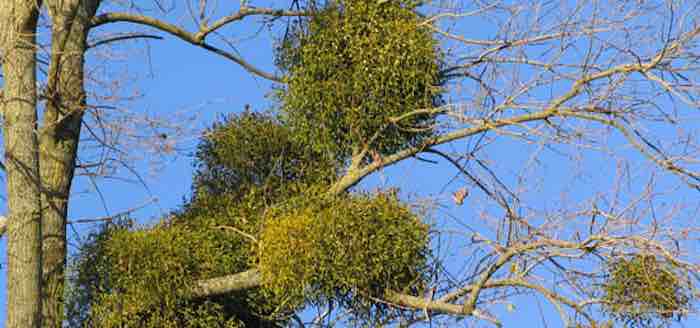 Few of the over 4,000 species of known parasitic plants are of economic importance. Those that are however can cause 80 percent crop losses.
Some of the most infamous of these are the Dodders, Cuscuta, ironically of the of the Morning Glory (Convolvulaceae) family. Common names for various species indicate the hatred held for string-like stems: Devil's Guts, Devil's Hair, and Witch's Hair. In medieval Europe, dodder was sometimes viewed as evil transformation of normal grape wine species. As late as 1831 the presence of dodder in crops was connected to the appearance of the comet in the previous year. Like other fully parasitic plants, it achieves its vampire act by means of haustoria, penetrating the host plant to suck its sap. Victims along with grape vines may include coffee shrubs, soybeans, asparagus, melons, chrysanthemums, petunias, garlic, oak trees, and tomatoes. Not all dodders achieve their evil design on tomatoes. As Susan Milius explained in Science News, a tomato plant poked by a haustorium of C. reflexa, however, panics. A patch of cells on the stem elongate and bursts, forming a scab that stops the intruder. The haustorium stalls and eventually dies.
Few of the over 4,000 species of known parasitic plants are of economic importance. Those that are however can cause 80 percent crop losses.
Some of the most infamous of these are the Dodders, Cuscuta, ironically of the of the Morning Glory (Convolvulaceae) family. Common names for various species indicate the hatred held for string-like stems: Devil's Guts, Devil's Hair, and Witch's Hair. In medieval Europe, dodder was sometimes viewed as evil transformation of normal grape wine species. As late as 1831 the presence of dodder in crops was connected to the appearance of the comet in the previous year. Like other fully parasitic plants, it achieves its vampire act by means of haustoria, penetrating the host plant to suck its sap. Victims along with grape vines may include coffee shrubs, soybeans, asparagus, melons, chrysanthemums, petunias, garlic, oak trees, and tomatoes. Not all dodders achieve their evil design on tomatoes. As Susan Milius explained in Science News, a tomato plant poked by a haustorium of C. reflexa, however, panics. A patch of cells on the stem elongate and bursts, forming a scab that stops the intruder. The haustorium stalls and eventually dies.The Comment section of online publications is the new front in the ongoing Cancel Culture Battle.
Big Tech and Big Media are gunning for the Conservative Voice—through their Comment Sections.
Canada Free Press wishes to stay in the fight, and we want our fans, followers, commenters there with us.
We ask only that commenters keep it civil, keep it clean.
Thank You for your patience and for staying aboard the CFP ‘Mother Ship’.
READ OUR Commenting Policy